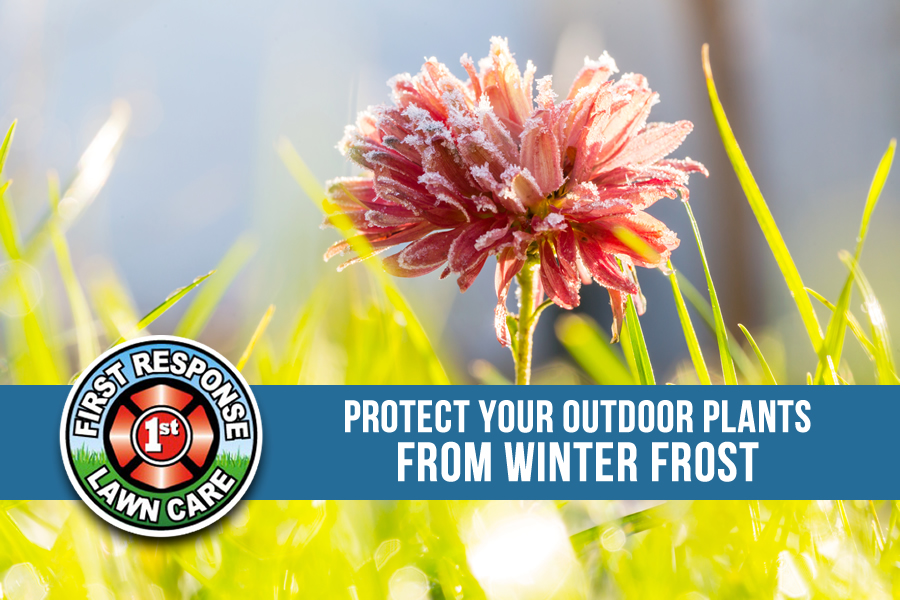
by admin | Feb 9, 2018 | Lawn Care 101
Low temperatures are being forecast for this weekend in much of Texas as a winter storm slides through the Dallas metro area. Time to talk about protecting outdoor plants from Texas frost. One day it’s 55 and sunny. The next, it’s 32 with frost on the ground. Welcome to Texas ya’all. Fluctuating temperatures are a common occurrence around here. Back to the pending freeze tomorrow. You may need to protect your outdoor plants and flowers from the freeze and/or frost.
The warmth we’ve had may be enough to keep a plant from freezing during a short cold snap. For added protection, you can protect plants in a freeze by placing a sheet or blanket over the plant and then putting a piece of plastic over the sheet or blanket to help keep warmth in. Never cover a plant with just plastic, however, as the plastic will damage the plant.
You can cover larger plants (trees and shrubs) with old bed sheets, burlap, or commercial frost cloths (avoid using plastic). For best results, drape the cover over a frame to keep it from touching the foliage.
Be sure to uncover them in the morning when the temperature rises above freezing.
Stay warm friends since the Groundhog Day rodent, Woodstock Willie, did see his shadow and predicted six more weeks of winter weather from February 2nd!
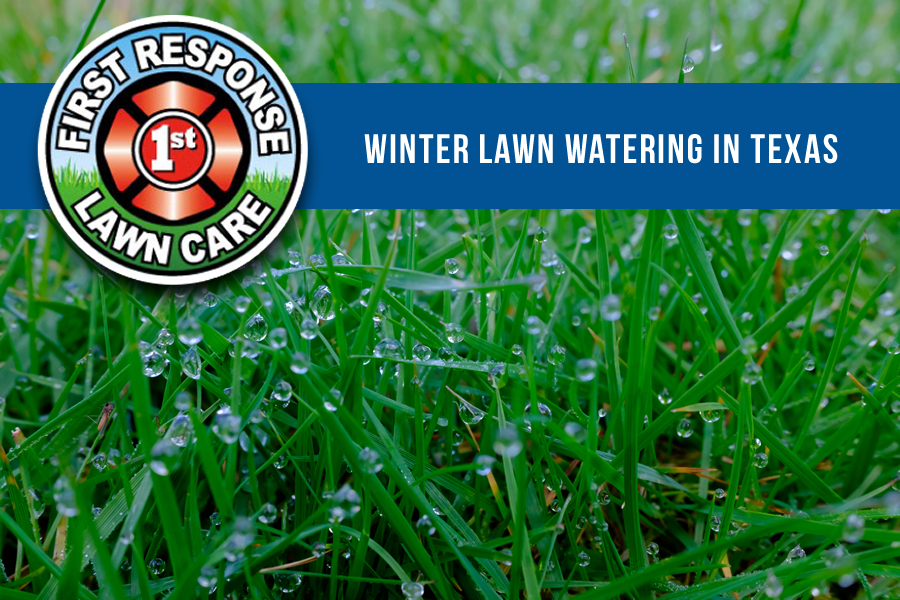
by admin | Jan 11, 2018 | Lawn Care 101, Lawn Maintenance Rockwall, Watering
The burning question this week is “Should I water my lawn in the winter”? And the answer is, “YES”! Your grass needs about 1 to 2 inches of water per week, including rainfall depending upon your type of grass.
During the periods of prolonged winter drought, if the air temperature is above freezing and the soil isn’t frozen, you should water every two or three weeks for 15 to 20 minutes – just enough to provide moisture to the crown and roots and counteract the drying effects of winter winds. Time afternoon watering so grass blades don’t remain moist overnight, which minimizes the threat of fungal diseases. If your grass is long and lush, you can try deep soaking. This allows the water to penetrate deep into the sub-soil and root zone of the grass, six inches deep. If you cut your lawn severely last fall or mow it in winter so that top growth is very short, it will dry out even faster. Even in winter, it’s best to leave your grass tall.
It’s also important to know your grass type. Cool season grasses like fescue, rye or even bluegrass do not necessarily go completely dormant during the winter months. It’s a good idea to water them every now and then when there is no forecast of a hard freeze. Texas generally has Bermuda, Zoysia, St. Augustine, and centipede grasses, which are warm-season grasses. These go dormant once temperatures drop below freezing. The combinations of warm and cool season grasses might include Bermuda and rye or Zoysia combined with fescue or rye. With all these combinations, the result is often the same – a two-tone lawn.

by admin | Oct 20, 2017 | Holiday Light Installation Rockwall
Brighten up your neighborhood by having a professional company install amazing lights and decorations. Let First Response Lawn care provide your holiday and Christmas lighting service this year. We can eliminate the time and expenses you spend dealing with outside Christmas decorations. Professional holiday lights and decoration services take a serious burden and potential hazard of falling off ladders and roofs for home owners preparing for the holidays.
We Make it Easy!
From rope lights to rooftop icicles, and net lighting to wreaths, we do everything for your outdoor holiday light display. Get your tree trunks wrapped with mini-lights? We’ve got you covered. Want a group of snow covered Christmas trees in your yard or in front of your restaurant? We can do it!
First Response Lawn Care handles residential and commercial lighting displays for the holidays. Call us today and let’s talk about how we can help make this holiday your brightest ever!
Call now to schedule your holiday lighting services (214) 701-7622.
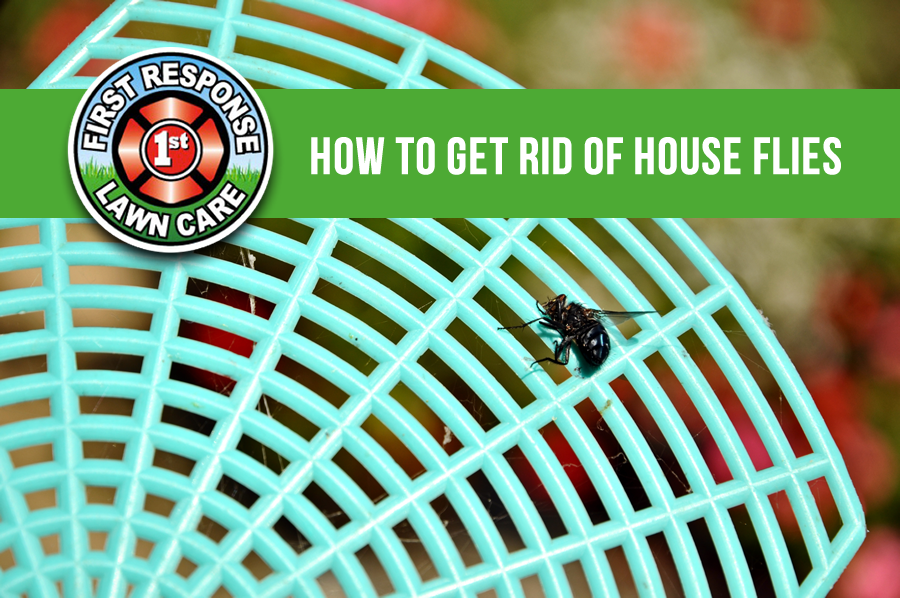
by admin | Oct 13, 2017 | House Flies
With the cooler weather, we tend to leave the doors open more often. That invites the old house flies in and the annoying swatting begins. Flies can cause problems, especially when it comes to contaminating your food. While the average house fly does not bite people, it can spread disease and pathogens by laying eggs on your food and other surfaces. Get rid of flies by making a do-it-yourself trap using dish soap, making a do-it-yourself repellent using cayenne pepper or herbs like mint, or buying a commercial trap.
Keep in mind that preventing flies from coming into your home is just as important as removing them. You’ll need to be mindful of leaving doors or windows without screens open. Check your sealing and insulation. Doors and windows should be closed and sealed to prevent flies and other insects from coming in.
So we are addressing what happens once the pests have made their way in your home. You’ll need to make the area seem less appealing as a potential food or housing source. Here are our top 5 tips:
Set a trap with dish soap. Pour 1 inch (2.54 cm) of liquid dish soap into a jar and add 1 inch (2.54 cm) of water. The flies will be attracted to the soap and drown in the water.
- Use fruit flavored dish soap for best results. An apple scented soap or lemon soap may provide better results, for example.
- Add a drop or two of apple cider vinegar if you do not seem to be catching many flies. The vinegar will attract flies to the jar.
Mix a natural fly repellent in a spray bottle. Flies will stay away from the scent of cayenne pepper. Mix a little in a spray bottle with water.
- Spray the cayenne mixture in doorways, window sills and other cracks and corners where flies might try to come in. The smell of the cayenne will keep them out.
Plant herbs to repel flies. They do not like scents such as lavender, basil and mint. Set up an herb garden in your kitchen or window sills to keep flies out.
- Use marigolds if you prefer flowers to herbs. Marigolds are offensive to flies.
Outsmart flies with plastic bags full of water. The way the bags and water reflect light will resemble a spider’s web, and flies always try to avoid those.
- Fill clear plastic bags halfway with water. Seal the bags and hang them near doors and windows.
- Hang old CDs and DVDs to achieve the same light effect.
Purchase flypaper. This can be found at hardware stores, department stores and home improvement retailers. Flies will stick to the paper and be unable to fly away.
- Remove the flypaper and discard it when too many flies begin to accumulate. Not only will it cease to be useful, a crowded strip of flypaper often looks unattractive.
Consider a fly light. You can buy a special light that keeps flies away from your kitchen or home. Many restaurants use this type of device.
Throw out fruits and vegetables before they get too old to eat. Whenever possible, keep them in the refrigerator instead of out in the kitchen.
Keep all of your trash sealed. Flies are attracted to garbage, especially any decaying food.
Clean your floors, countertops and other surfaces thoroughly. Be sure not to leave crumbs or spills.
You could buy a venus fly trap plant.
Happy fly trapping!

by admin | Sep 29, 2017 | Fall Vegetable Garden Prep
We celebrated our first day of Fall on September 22nd. Now it’s time to think about prepping our veggie beds for Fall as the temperatures begin to cool down. It’s best to prepare your soil in the Fall while the earth is still warm and workable. There are just a few simple steps to Fall soil preparation:
WEEDING
Now is the time to dig out the roots of problem weeds like wild morning glory, oxalis, nut sedge and Bermuda grass. Be sure to remove any others with seed still on the plant. If shed, this seed can easily winter over in the soil to infest the new year’s bed. It’s a common occurrence in spring prepped soils to find weed populations increasing with each new season.
FEEDING
Spread amendments evenly over the area before you till. You’ll need a lot of manure and/or compost to feed microorganisms and help the soil remain open and well-drained. Then boost fertility with materials such as bone meal for nitrogen and rock phosphate for phosphorous. An easy way to achieve this is to buy a complete organic fertilizer in pellet or granular form, which is easy to transport and apply.
TILLING
Fall tilling is all about opening up the soil to incorporate nourishment, relieve compaction, increase oxygen and improve drainage. The deeper you get, the better. Because you’re not planting right away, it’s best to rough till once in each direction. This leaves the surface irregular with large chunks of earth. The clods will gradually erode over the course of the winter, carrying amendments deeper down with the runoff. You can spread the entire surface with mulch or shredded leaves to prevent erosion. The ground will flatten out considerably by spring when you’ll need only fine till to prepare for planting.
Come spring 2018, you’ll be pleasantly surprised how much easier it will be to put the garden in without all that hauling, spreading and tilling.

by admin | Sep 22, 2017 | Gardening Tips, Lawn Pests
You can find these pesky caterpillars feeding on your various garden plants like tomato, eggplant, pepper, and potato. Hornworms can be hard to spot because they blend in with the plant leaves. They literally look like a leaf in their coloring. If you see dark spots on your leaves, look underneath and you may find one of these buggers. If you don’t see them in time, they can take your plants down to a nub in a matter of days.
Factoids about Hornworms
All living creatures serve a purpose, so what’s the purpose of the pesky hornworm? Well, it matures into a beautiful sphinx moth that resembles a miniature hummingbird.
With that hook on one end, it sure looks like it might sting or bite, but nope. A hornworm’s horn doesn’t sting and is no threat to humans. If you poke one, you may be treated to a defensive response. The hornworm will rear up, looking as threatening as possible, and make loud clicking noises.
Wasps are a great ally in controlling hornworm populations. If you see a hornworm with what looks like grains of white rice stuck all over its back, it has been parasitized by a wasp. When the eggs hatch, the larvae will eat the hornworm. The wasps have a natural duty to keep the hornworms in check.
How to control Hornworms
Commercial and organic pesticides are available. Or you can pick them off your plant and transport them to another location. Remember, they do not bite or sting, and the worst thing that can happen is they will make a loud clicking sound.
As mentioned in our factoids, if you see the hornworm covered in white egg sacs that look like rice, leave that hornworm alone. The egg sacs are those parasitic wasps called the Braconid wasp. Let the eggs hatch. Then you’ll have an army of wasps to defend your garden against all types of pests. These wasps are not a threat to humans.
Preventing future Hornworms
Tilling your garden after your harvest and again in early spring, can kill the majority of the overwintering pests and reduce hornworm problems for the coming year.
If you need help with your lawn maintenance, call First Response Lawn Care today!
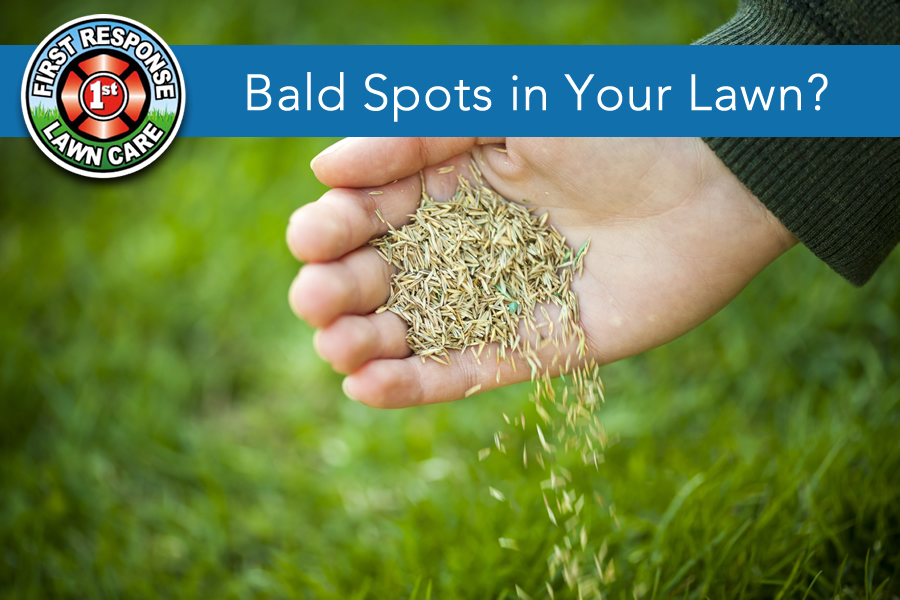
by admin | Sep 15, 2017 | Lawn Care 101
Do you have bald spots in your lawn? Before the turf can be treated, you need to determine the root, pardon the pun, of the problem. If you eliminate pests and fungus as causes, you may just find that you need some seeds.
Good seed-to-soil contact will get the seeds germinating fast. Using a sharp spade or shovel, cut the area around the dead turf. Then, use the flat part of the spade to lift off the dead turf. Because you are removing at least a couple of inches of thatch and grass, fill in the area with some clean topsoil to keep it level with the rest of the yard.
Rake out the area until it is smooth and there are no big clumps in the soil. Cast a thin layer of seeds on the area, and then gently rake the seeds into the topsoil. Cover it with straw to hold in moisture and protect the seeds from birds.
If your lawn seems thin all over, try overseeding it. The basics are the same as patching. Rake the area well, picking up any leaves and debris in the turf. Cast the seeds over the turf, and then spread about a half an inch of compost or topsoil on the lawn. To get good seed-to-soil contact, gently rake the seeds and soil into the grass.
If you don’t have time to patch your lawn, call a professional. First Response Lawn Care is here to help with your bald spots—on your lawn!
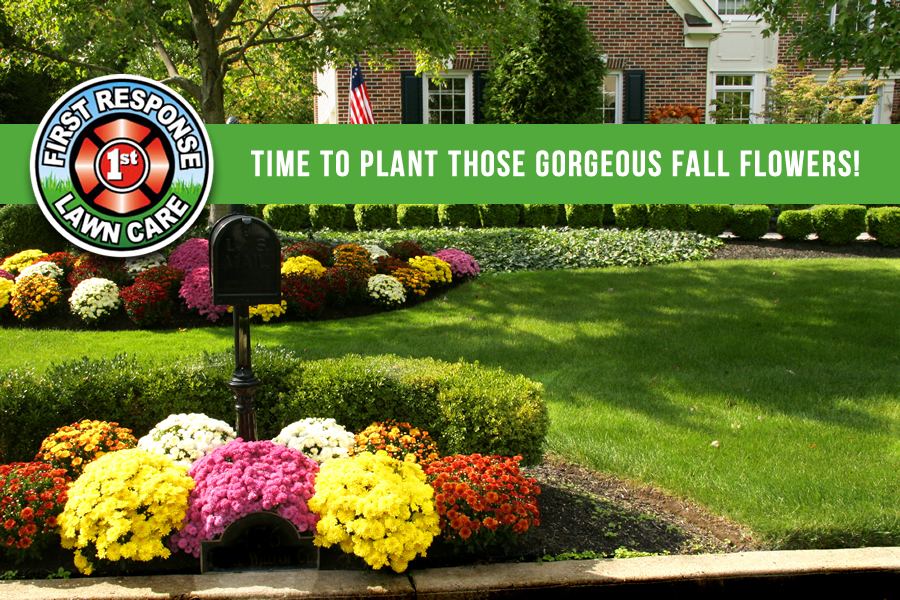
by admin | Sep 8, 2017 | Fall Flowers in Texas, Landscaping Rockwall
It’s not too early to start thinking about your Fall landscape. Now’s the time to decide on the best show of flowers for your yard. Let’s talk about a few choices you have for a beautiful display of Fall color –
Chrysanthemums (“Mums”)
Plant fall-blooming annual mums for seasonal color. Mums remind us of football and Halloween. These fall favorites ignite a landscape with blazing color. The first step is to buy the right kind of mums. Not all garden mums are created equal in terms of surviving winter cold. When buying garden mums, look for tags that say hardy mums or garden mums, as opposed to the less hardy florist mums or cutting mums.
The best time to plant fall purchased garden mums is the minute you buy them, which should be as soon as you see them for sale. Early planting—even as early as September —helps plants develop a strong root system. Plant garden mums too late, and winter freeze-thaw cycles can shove plants out of soil, a condition known as frost heave. Without early planting to permit strong root growth, shallow rooted garden mums don’t really stand a chance.
After planting garden mums, don’t forget to water throughout fall. It’s also wise to add mulch at planting time over plant roots. Once soil freezes, add another mulch layer around the base of garden mums to help insulate soil and prevent frost heave.
Marigolds
Marigolds come in a variety of warm colors. Other than mums, there aren’t many plants that give exceptional fall color. Factoid: African marigolds planted in fall will out-bloom any chrysanthemum.
The best time to plant marigolds in the garden is during the first few weeks of September. Even though they are often thought of as a spring through summer flower, they really perform much better from late summer up until first frost. You can use them to fill holes in your borders, add color to your fall display, and to mass plant. Tip: Plant marigolds around your Fall vegetable garden to deter insects because of their strong fragrance.
To ensure success with marigolds, establish your beds with good soil prep and proper drainage, and always hand-water the first several weeks to allow roots to establish. Don’t give marigolds any shade at all. Do not over water or give them less than full, blasting Texas sun.
Zinnias
Plant some dwarf (low growing) or giant (reach up to 4′ tall) zinnias for a vibrant bright display of color. Zinnias are annuals, so they grow for one season and make great cutting flowers, but do not come back in subsequent years.
Usually, fall zinnias of all types begin showing up in Texas garden centers in September. They need full sunlight for a half day or more, and will thrive as long as they have moderate water and are planted in a well-drained soil.
Zinnias are one of the easiest annuals to grow. Outstanding in beds, borders, and containers, and they attract butterflies to your garden.
Let us know your favorite Texas Fall flower! And if you need help planting, call First Response Lawn Care today at (214) 701-7622!
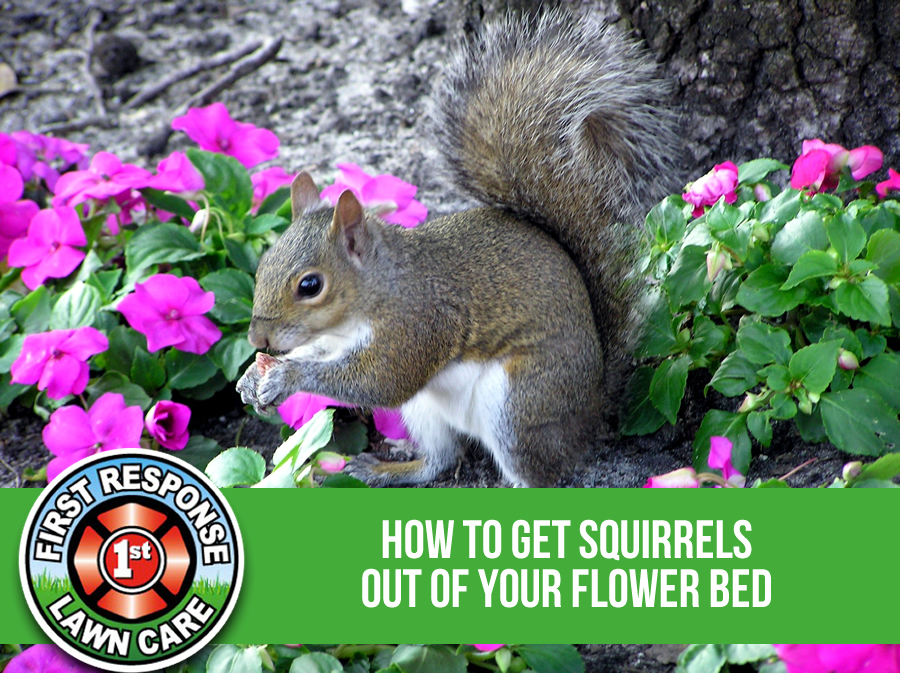
by admin | Sep 1, 2017 | Lawn Pests
Are you fed up with squirrels digging in your potted plants or eating your flowers? We are hearing more and more customer complaints about the battle between gardener and squirrel. Squirrels can cause a lot of damage in potted plants and the garden, and we know many of you have gone out to tend to your carefully planted containers only to find chaos, with pots knocked over, bulbs gone, and plants and flowers uprooted. On investigation of the remaining soil in the pot you may have found buried whole nuts or shells. The squirrels from H-E-double hockey sticks have visited….
How to stop squirrels from digging
Here are a few tricks to stop these pests from becoming a serious nuisance. These work best with container gardening but they can also be applied directly to small areas of your garden beds.
The most obvious way to stop squirrels in their tracks is to put physical barriers in their way. One of the most commonly used tricks to keep squirrels out of potted plants is to put something in the pots that the squirrels won’t like. We aren’t encouraging poisoning or harming the critters, just keeping them away from your potted plants and garden. Here are our top 7 ways to deter squirrels –
- Try covering the surface of the pot with attractive rocks and stones. The squirrels won’t be able to budge them and yet they’ll enhance the appearance of your garden containers.
- Try laying chicken wire just under the top level of soil when planting bulbs to prevent squirrels from digging them out. Remove it when shoots appear.
- Mix in fresh, strong smelling coffee grounds with the top layer of soil. The odor is repellent to squirrels but does them no harm.
- Or make your own hot pepper spray. You can make pepper spray by combining a couple of teaspoons of washing up liquid with a small bottle of hot pepper sauce and water. Put it into a plastic spray bottle to apply. Commercial pepper sprays are also available specifically for keeping squirrels away from plants and gardens. If you don’t want to actually spray your plants, sprinkle hot red pepper flakes or powder in the soil around the plants to keep squirrels away. Of course you’ll need to repeat this regularly, especially after each time it rains. They do not like the spiciness at all and they will avoid any area that has been treated. You can make pepper spray by combining a couple of teaspoons of washing up liquid with a small bottle of hot pepper sauce and water. Put it into a plastic spray bottle to apply. Commercial pepper sprays are also available specifically for keeping squirrels away from plants and gardens. If you don’t want to actually spray your plants, sprinkle hot red pepper flakes or powder in the soil around the plants to keep squirrels away. Of course you’ll need to repeat this regularly, especially after each time it rains.
- Bone meal is also repulsive to squirrels. It is a natural fertilizer high in nitrogen and ammonia, and has a strong scent that deters squirrels. The added bonus is that you will be adding nitrogen to your soil at the same time!
- There are organic products on the market with non-toxic repellents such as Nature’s Defense.. It is safe to use around children, pets, plants and food crops.
- Ultrasonic technology is also available and very affordable like this Solar Yard Guard Ultrasonic Animal Repeller from Target.
Squirrel repellent can be a valuable tool when you are trying to protect your bulbs, flowers and plants. Squirrels are tenacious and we know this is an on-going battle, but hopefully one of the above tricks will work for you.
First Response Lawn Care is here for you. If you need any help with lawn maintenance or just want to talk about squirrels, give us a call at 214-
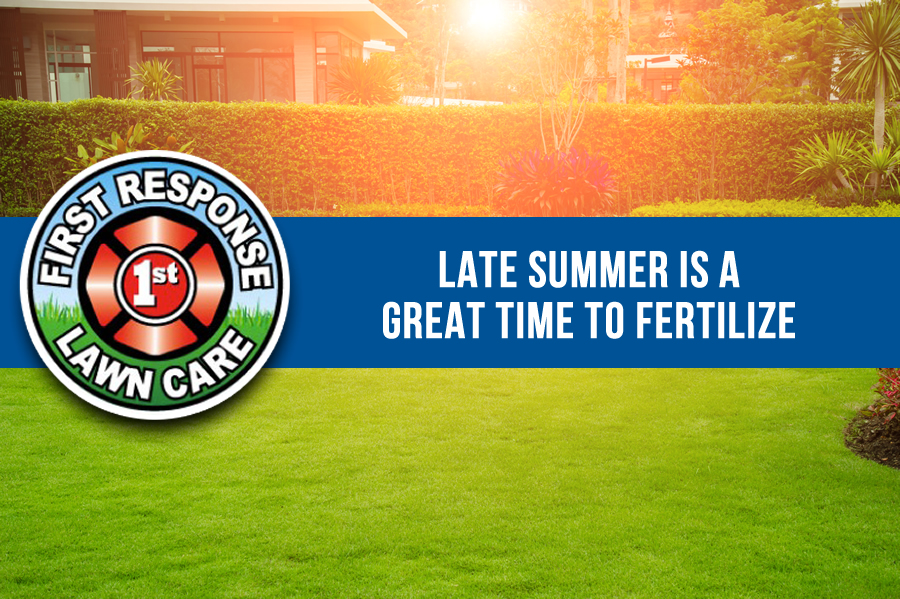
by admin | Aug 25, 2017 | Herbicides, Lawn Care 101, Texas Summer Lawn Care Tips
Hey North Texas, late summer is a great time to fertilize your lawn. Summer is tough on grass. Heat, drought, foot traffic, and insects stress it out to the max. Feeding your lawn in the late summer protects and strengthens it against these problems.
Lawns in warm-season grass areas should be fed over the summer months as they grow steadily from spring to fall. If you see insects in your grass, it’s time to also incorporate insect control.
In the late summer and early fall, root growth begins again because of the decrease in soil temperature and increase in natural rainfall. The grass will green up again with the production of new roots and shoots and damaged patches will start to disappear. Fertilizing at this time will provide the nutrients the grass needs to recover and re-grow rapidly.
The fertilizer you apply in the late summer will be used up by the plant to grow shoots and roots, rather than being stored in plant tissue for use in the future.
Proper fertilization can keep your grass thick and healthy. This helps the lawn resist insects and diseases and makes it harder for weeds to grow. Fertilizers release minerals and nutrients in a “slow release” form. Clients ask us all of the time if it’s too late to make their lawn better and we say it’s never too late with a good routine of weeding, feeding and aerating.
With the fertilization in late Summer, you’ll see improvement in color, growth and health of your lawn.
If you aren’t on a regular schedule to feed your lawn, call First Response Lawn Care today and let’s get started on a plan for your lawn!










